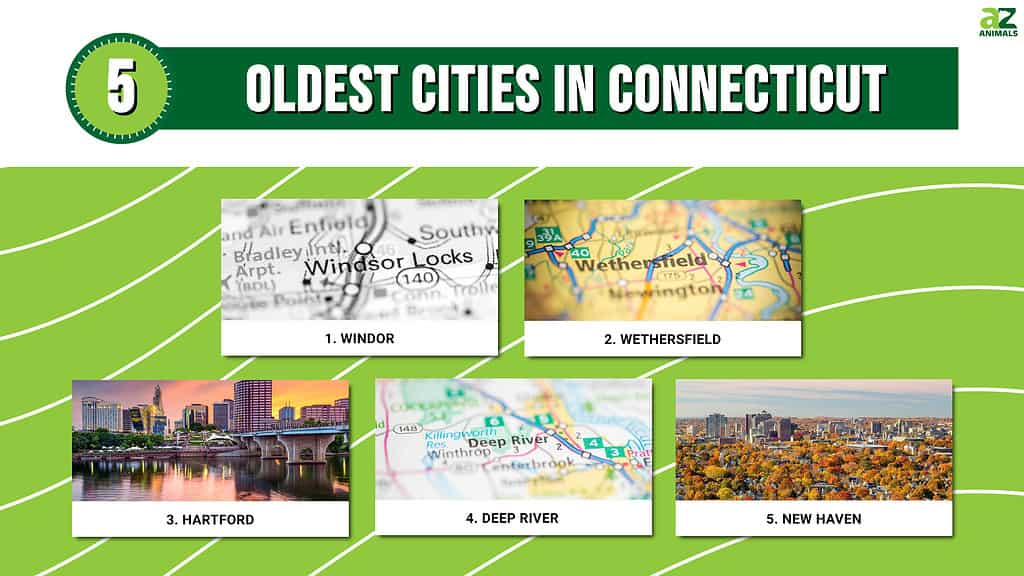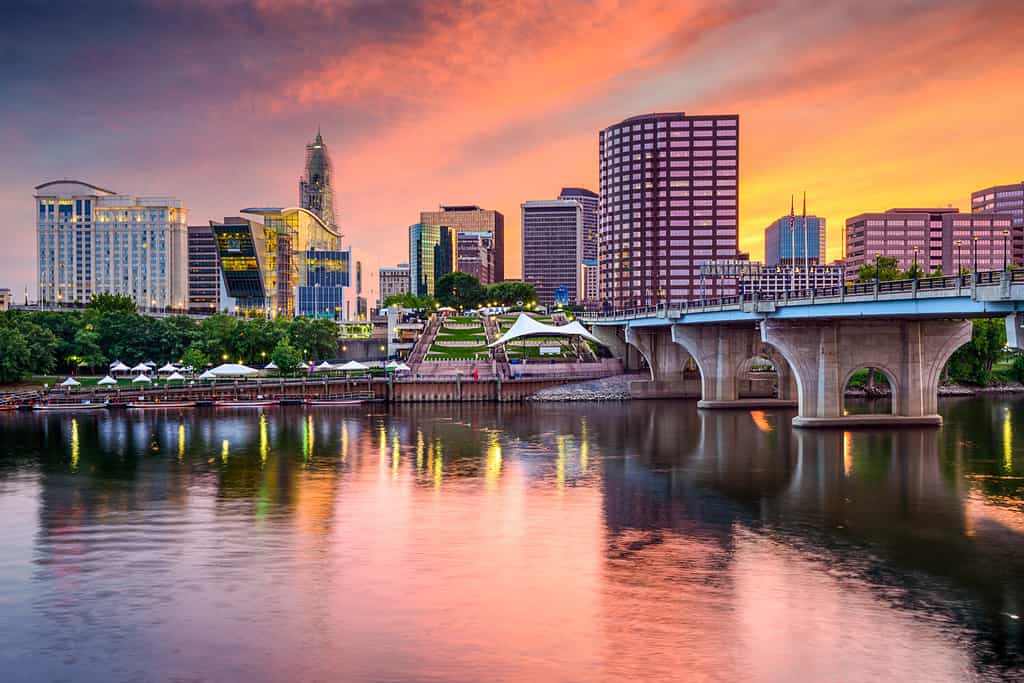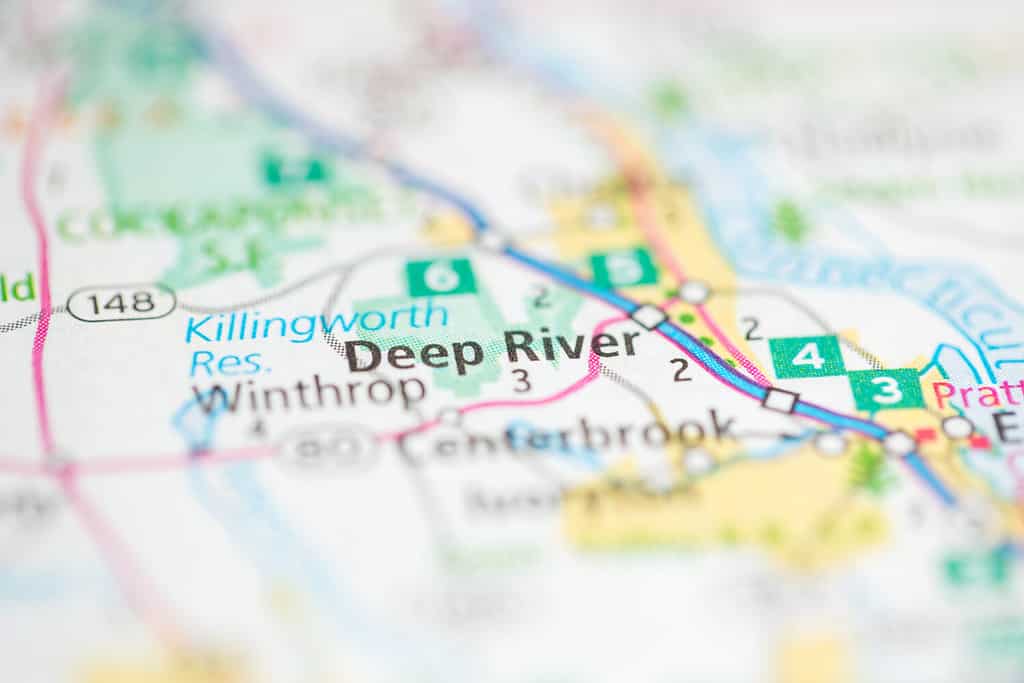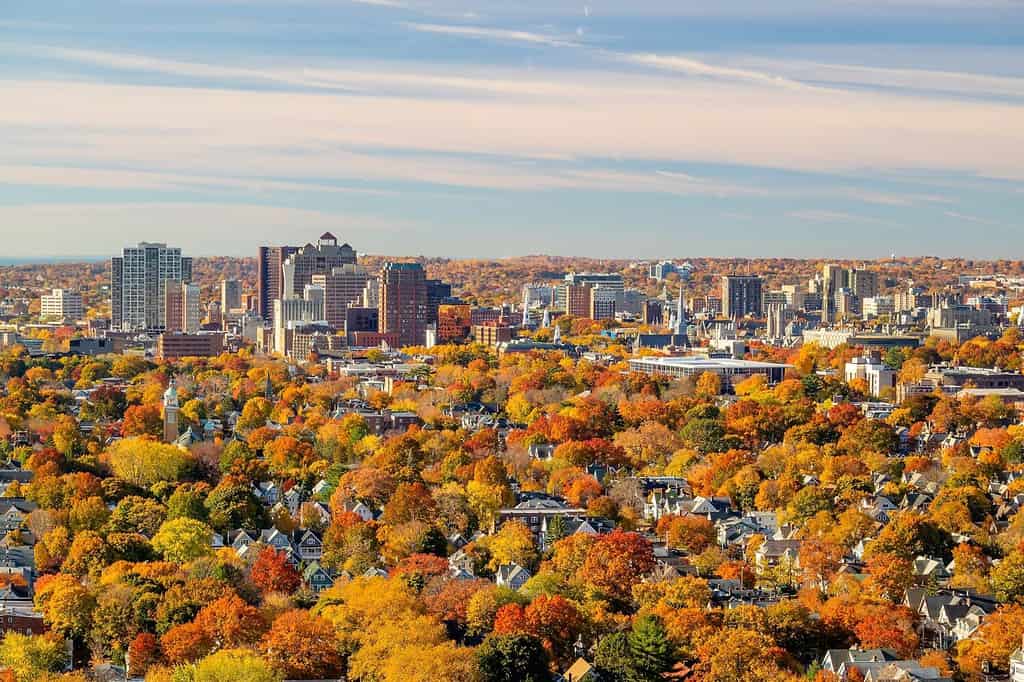The land where the first constitution was written in the United States has a rich history. This led to Connecticut’s nickname, the Constitution State. This legal document, called the Fundamental Orders was adopted by the Connecticut Colony Council in 1639. There’s no doubt Connecticut has a rich history, but do you know how far back it dates? Let’s look at the oldest cities in Connecticut!

The Northeastern state has many historical landmarks. These include Yale University, the house where Mark Twain once lived, and the oldest newspaper in the country (which is still running). Connecticut is also where the first Thanksgiving took place.
Connecticut is named after its central Connecticut River, which runs through it. The state is surrounded by Long Island Sound, New York, Massachusetts, and Rhode Island. It’s the third of the trio in the Tri-state area alongside New York and New Jersey. Connecticut is also one of the states in the New England region.
It’s the third-smallest state by area but the fourth most densely populated. Connecticut has a total of 3.6 million residents as of 2020. Hartford is the state’s capital, while Bridgeport is its most populous city.
Early Establishments
Dutchmen founded a small, transient town called House of Hope in Hartford near the Park and Connecticut Rivers meeting point. These were Connecticut’s first European inhabitants. While the English built the first colonies in the 1630s, this Dutch colony originally comprised half the state. This colony covered much of the territory between the Connecticut and Delaware Rivers. Massachusetts Bay Colony native Thomas Hooker established the Connecticut Colony under his leadership.
Connecticut Colony was one of the Thirteen Colonies that opposed British control during the American Revolution.
Connecticut has a long history as the fifth state admitted to the Union in 1788. Most of its oldest cities and towns still have well-preserved historical records.
The 5 Oldest Cities In Connecticut
#1 Windsor

Founded in 1633, Windsor is one of the oldest cities in Connecticut.
©SevenMaps/Shutterstock.com
Windsor (formerly known as Dorchester) is Connecticut’s oldest city. It was founded in 1633 as the first English settlement in the state. It was a prized location for many reasons. A war between local Native Americans in the 17th century was complicated by emerging European interests in the fur trade. Windsor was prized due to its high agricultural potential and connection to the Farmington and Connecticut Rivers.
Windsor was established by a group from Plymouth Colony. They sailed there on a ship on September 26, 1633, and brought the building supplies for a trading house. The house was built on a plot purchased from the original Indigenous landowners. This plot was located 80 to 100 rods below the Farmington River’s mouth.
With this plot of land secured, the settlers quickly built homes. By the summer of 1635, they had stocked their lands with cattle and servants. The land was eventually sold in 1637 to settlers from Dorchester, Massachusetts. These new migrants had already arrived in the area in 1635. The settlers from Dorchester arrived in Windsor under the leadership of Reverend John Warham. This man gave the city the original name of Dorchester. Warham led the congregation at the First Church in Windsor for many years.
Settlement Of Windsor
The original Windsor colony included Windsor town and present-day Coventry, Tolland, Enfield, Litchfield, Suffield, and Simsbury towns.
The colony’s General Court renamed the settlement from Dorchester to Windsor on February 21, 1637. This was done in honor of Windsor, Berkshire, an English town on the River Thames.
Numerous historic homesteads in the town date back to the 1700s. Notable sites include the Windsor Historical Society, Oliver Ellsworth House, and CT Valley Agricultural Museum. The Northwest Park and the Vintage Radio and Communications Museum of Connecticut are also there.
#2 Wethersfield

In the 1800s, Wethersfield’s economy was driven by a state jail and commercial seed production.
©SevenMaps/Shutterstock.com
Wethersfield is the second oldest town in Connecticut, established in 1634 by the “Ten Adventurers.” They were a group of Puritan settlers, including John Oldham, Robert Seeley, Thomas Topping, and Nathaniel Foote.
With the Massachusetts General Court’s approval to purchase the Watertown land, they permanently moved to Connecticut. The settlement was known as “Watertown,” taking its name from Watertown, Massachusetts, before its incorporation as a town (alongside Windsor and Hartford) on February 21, 1637. The name was changed to Wethersfield after a county in Essex, England.
It endured witch hunts in the beginning but gained prominence as prosperity from trade, shipbuilding, and onion farming spread. Then, in 1638, the town built its own cemetery on Hungry Hill, the Old Wethersfield Village Cemetery.
Wethersfield’s Early Days
Wethersfield’s economy was driven by a state jail and commercial seed production in the 1800s, and in the 20th century, it evolved into a Hartford suburb with a burgeoning residential population.
Wethersfield is symbolized through one of the three grapevines on the state flag as one of the three oldest English colonies in the state.
With 1,100 structures dating to the 17th, 18th, and 19th centuries and a total area of 2 square miles (5.2 square kilometers), Old Wethersfield is the largest historic neighborhood in the state. It was listed on the National Register of Historic Places in 1970.
Silas Deane, an American Revolutionary War diplomat to France, lived on Main Street in the district. Today, his house is maintained and run as a component of the Webb-Deane-Stevens Museum. Joseph Webb House, Buttolph-Williams House, and the First Church of Christ, Wethersfield, are other prominent sites in Old Wethersfield.
Wethersfield is situated just south of Hartford by the Connecticut River. As of the 2020 census, it had a population of 27,298.
#3 Hartford

Originally called Newtown, the settlement’s name changed to Hartford in 1637 to immortalize Stone’s homeland in Hertford, England.
©Sean Pavone/Shutterstock.com
The Dutch under Adriaen Block sailed to Connecticut in 1614 and are thought to have been the first Europeans to explore the area that became Hartford. New Amsterdam-based Dutch fur traders returned in 1623 to build a trading presence and reinforce the region for the Dutch West India Company.
The original site was on the Park River’s south side, in the Sheldon/Charter Oak area. This fort was called Fort Hoop or the “House of Hope.”
Thomas Hooker and Samuel Stone, two Puritan preachers, and Governor John Haynes led 100 settlers and 130 cattle on a journey from Newtown in the Massachusetts Bay Colony (present-day Cambridge) to establish their settlement north of the Dutch fort in 1635. This settlement was initially known as Newtown, but Hartford was adopted in 1637 to immortalize Stone’s homeland in Hertford, England.
The Beginnings Of Hartford
Hooker was so influential in Hartford that his 1638 sermon was the impetus for the creation of the Fundamental Orders of Connecticut, which was the foundation for Connecticut’s secession from the Massachusetts Bay Colony and the establishment of a civil government.
Hartford was designated as Connecticut’s capital in 1875. New Haven and Hartford had earlier been dual capitals as a condition of the deal that saw the Colony of New Haven merged into the Colony of Connecticut in 1664.
The capital city hosts many historic places, including the oldest publicly funded park, Bushnell Park; The Mark Twain House and Museum, the second-oldest secondary school; Hartford Public School, the oldest publicly funded park; Wadsworth Atheneum.
With the headquarters of several insurance companies, the city is known as the “Insurance Capital of the World” and has earned its status as a global city.
#4 Deep River

America was the world’s largest ivory consumer between 1840 and 1940, and most of the ivory was shipped to Deep River.
©SevenMaps/Shutterstock.com
One look around the old town of Deep River, and it may be difficult to tell it was once dubbed the Queen of the Valley. Looking deeply, you will find enduring reminders of the town’s flourishing local economy. The historic homes dotting the townscape will take you back in time. The town became prosperous through the ivory trade, mainly producing piano keys.
America was the world’s largest ivory consumer between 1840 and 1940, and most of the ivory was shipped to Deep River.
Established in 1635, Deep River was once known as Eight Mile Meadow, or Potapaug Quarter, and was a part of the Saybrook Colony. From the early to mid-19th century, many component towns split from Saybrook Colony and became independent.
Deep River: Beginnings
Deep River was incorporated in 1859 as Saybrook; the name was coined after two of the state’s aristocratic founders, Viscount Saye & Sele and Lord Brooke.
Saybrook’s name was changed to “Deep River” in 1947 to coincide with the name of the town center village. The new name references the river that previously provided the energy for mills and factories, not the Connecticut River on its eastern border.
Deep River is within Middlesex County, and the town center has been classified as a census-designated place (CDP) by the U.S. Census Bureau. Deep River, Chester, and Essex are the three towns that make up what the locals call the “Tri-town Area.”
Notable historic structures in the town include Mount St John School, Abner Kirtland House, Deep River Public Library, The Stone House, and Deep River Congregational Church.
#5 New Haven

Eight streets were built in a four-by-four grid to establish the “Nine Square Plan” of New Haven.
©f11photo/Shutterstock.com
New Haven was founded in 1638 after English Puritans arrived at the peak of the English Civil War. Eight streets were built in a four-by-four grid, establishing the “Nine Square Plan” a year after the settlement was founded.
The 16-acre (6 ha) New Haven Green, which sits in the heart of Downtown New Haven, is the neighborhood’s main common block. The “Nine Square Plan” has been designated by the American Planning Association as a National Planning Landmark, while the Green has been listed as a National Historic Landmark.
A small group of Puritans spent the winter around the New Haven port in 1637. By April 1638, Reverend John Davenport and London businessman Theophilus Eaton headed the main group of 500 Puritans who had departed the Massachusetts Bay Colony and arrived in the harbor.
They hoped to benefit from the region’s outstanding port potential by establishing a theological community with a government more closely aligned with the church than that in Massachusetts.
New Haven: Origin Story
In 1784, Roger Sherman, one of the signatories to the Constitution and the creator of the “Connecticut Compromise,” became the first mayor of the newly incorporated city of New Haven. As a result, new Haven was one of the first planned cities in the country.
From 1701, the city shared the role of Connecticut’s capital with Hartford. It lost that role in 1873 due to Hartford’s central location. Yale University, the third-oldest college in the country, is also proudly housed in New Haven. The university was established in 1701 and was one of the nine colonial colleges chartered before the American Revolution.
New Haven is on the northern side of Long Island Sound, on New Haven Harbor. As of the 2020 U.S. Census, New Haven has a population of 135,081, making it the third-largest city in Connecticut after Bridgeport and Stamford. It’s part of the New York metropolitan area and the principal municipality of Greater New Haven, which had an overall population of 864,835 in 2020.
New Haven is also home to a natural harbor on Long Island Sound, one of the most important ports in the New England region.
Connecticut has 60 U.S. National Historic Landmarks, nine of which are in New Haven. They include Connecticut Hall, Lafayette Mendel House, Yale Bowl, Othniel Marsh House, Grove Street Cemetery, James Dwight Dana House, Connecticut Agricultural Experiment Station, Russell Henry Chittenden House, and New Haven Green.
Summary Of The 5 Oldest Cities In Connecticut
| Rank | City | Date Established |
|---|---|---|
| 1 | Windsor | 1633 |
| 2 | Wethersfield | 1634 |
| 3 | Hartford | 1635 |
| 4 | Deep River | 1635 |
| 5 | New Haven | 1638 |
The photo featured at the top of this post is © SevenMaps/Shutterstock.com
Thank you for reading! Have some feedback for us? Contact the AZ Animals editorial team.







